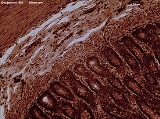
Jejunum
Overview
Small intestine
The small intestine is the part of the gastrointestinal tract following the stomach and followed by the large intestine, and is where much of the digestion and absorption of food takes place. In invertebrates such as worms, the terms "gastrointestinal tract" and "large intestine" are often used to...
in most higher vertebrates, including mammals, reptiles, and birds. In fish
Fish
Fish are a paraphyletic group of organisms that consist of all gill-bearing aquatic vertebrate animals that lack limbs with digits. Included in this definition are the living hagfish, lampreys, and cartilaginous and bony fish, as well as various extinct related groups...
, the divisions of the small intestine are not as clear and the terms middle intestine or mid-gut may be used instead of jejunum.
The jejunum lies between the duodenum
Duodenum
The duodenum is the first section of the small intestine in most higher vertebrates, including mammals, reptiles, and birds. In fish, the divisions of the small intestine are not as clear and the terms anterior intestine or proximal intestine may be used instead of duodenum...
and the ileum
Ileum
The ileum is the final section of the small intestine in most higher vertebrates, including mammals, reptiles, and birds. In fish, the divisions of the small intestine are not as clear and the terms posterior intestine or distal intestine may be used instead of ileum.The ileum follows the duodenum...
. The change from the duodenum to the jejunum is usually defined as the Duodenojejunal flexure
Duodenojejunal flexure
The duodenojejunal flexure or duodenojejunal junction is the border between the duodenum and the jejunum.The ascending portion of the duodenum ascends on the left side of the aorta, as far as the level of the upper border of the second lumbar vertebra, where it turns abruptly forward to become the...
and is attached, and thus "hung up", to the ventricle (see stomach
Stomach
The stomach is a muscular, hollow, dilated part of the alimentary canal which functions as an important organ of the digestive tract in some animals, including vertebrates, echinoderms, insects , and molluscs. It is involved in the second phase of digestion, following mastication .The stomach is...
) by the ligament of Treitz.
In adult human
Human
Humans are the only living species in the Homo genus...
s, the small intestine is usually between 5.5 and 6m long, 2.5m of which is the jejunum.
The pH
PH
In chemistry, pH is a measure of the acidity or basicity of an aqueous solution. Pure water is said to be neutral, with a pH close to 7.0 at . Solutions with a pH less than 7 are said to be acidic and solutions with a pH greater than 7 are basic or alkaline...
in the jejunum is usually between 7 and 9 (neutral or slightly alkaline).
If the jejunum is impacted by blunt force the emesis reflex will be initiated.
The jejunum and the ileum are suspended by mesentery
Mesentery
In anatomy, the mesentery is the double layer of peritoneum that suspends the jejunum and ileum from the posterior wall of the abdomen. Its meaning, however, is frequently extended to include double layers of peritoneum connecting various components of the abdominal cavity.-Mesentery :The...
which gives the bowel great mobility within the abdomen
Abdomen
In vertebrates such as mammals the abdomen constitutes the part of the body between the thorax and pelvis. The region enclosed by the abdomen is termed the abdominal cavity...
.

